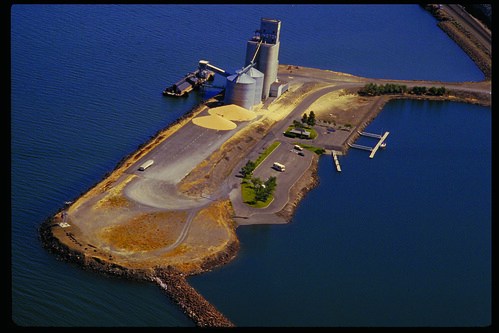
Asia-bound grains, including soybeans, are commonly shipped by rail to ports in the Pacific Northwest. The cost to ship by ocean is the main driver for the choice of port for export, because inland barge transportation to the Mississippi Gulf is usually more efficient and less expensive than rail. Photo courtesy Oregon Department of Agriculture.
Fall is harvest time and our rural communities are bustling with activity. For American soybean farmers the days start in the early dawn, and they stay until the last light is gone, tending fields that seem to stretch to the end of the world. But success for them relies on more than just growing a good crop. Their soybeans must also move efficiently from the fields to the far corners of the world.
Helping farmers understand the importance and impact of transportation trends is one of the services provided by USDA’s Agricultural Marketing Service (AMS). AMS helps growers and exporters by gathering agricultural transportation data for a wide array of publications that are available to everyone on our agricultural transportation website.
U.S. agricultural exports had a record-setting year in 2013, with U.S. agricultural exports reaching nearly $141 billion and supporting about a million U.S. jobs. Part of that success was the U.S. production cost advantage due to lower transportation costs. Now–although the U.S. is still the dominant country within the soybean market–our global market share is declining. This trend reflects the loss of our production cost advantage over countries like Brazil and Argentina.
Because of the impact it can have on the market, U.S. soybean farmers need to understand the transportation environment that links their fields to global markets. Any change in supply or demand can affect the transport system capacity. To help soybean producers understand the impacts of transportation trends, AMS recently released the study Eroding U.S. Soybean Competitiveness and Market Shares: What Is the Road Ahead?.
The results of the report suggest that the U.S. world market share could decline by 20 percentage points. The United States, Brazil, and Argentina market shares depend on each country’s exporting capacity, which in turn depends on the transportation infrastructure. And in the case of the world soybean market—the competitiveness of ocean freight rates.
Understanding the transportation issues at home are equally as important and AMS provides transportation profiles for corn, wheat and soybeans. These reports examine the implications of the recent trends and the transportation outlook in the United States. More data on grain transport—including prices, deliveries, movements, sales, and freight rates—is available through market reports, such as the weekly Grain Transportation Report issued every Thursday.
USDA continues to promote U.S. trade and to help America’s farmers and ranchers increase their productivity. Knowledge of the transportation environment is critical to our continued success and to expanding market opportunities for American agriculture.
No comments:
Post a Comment